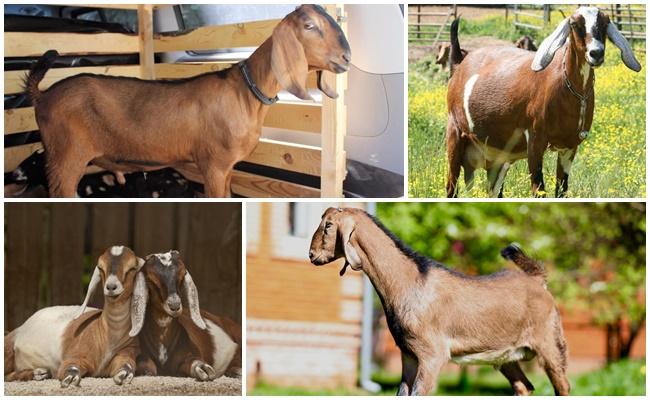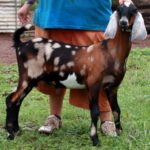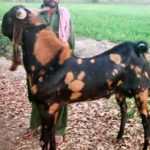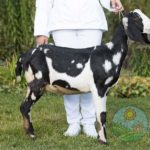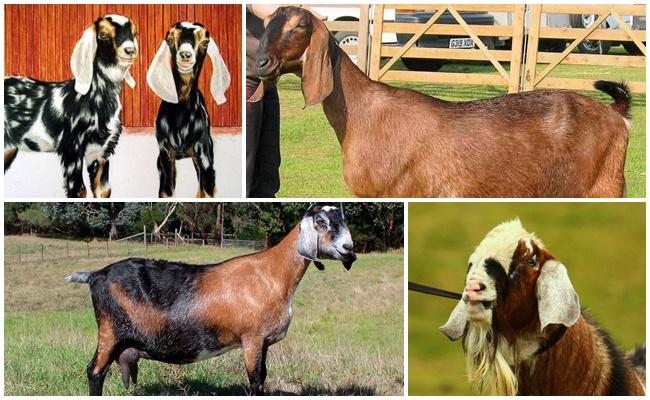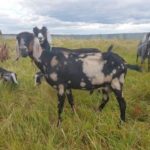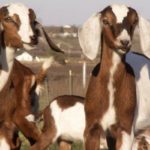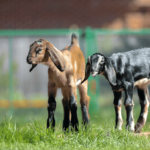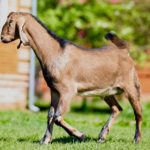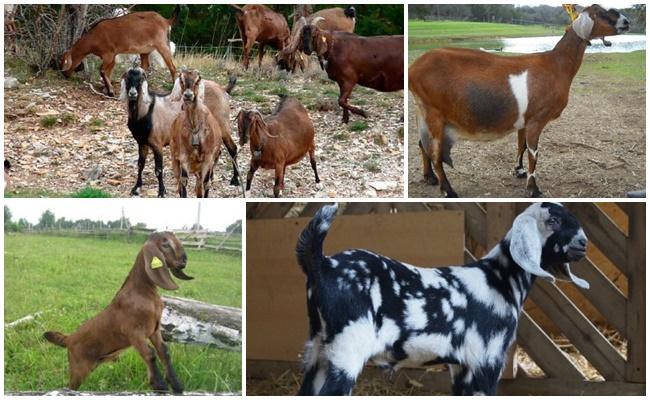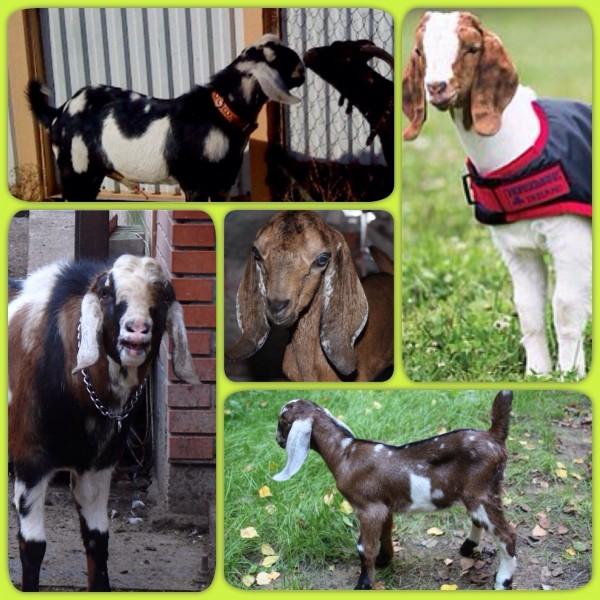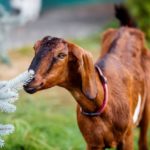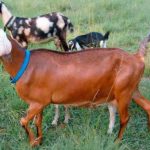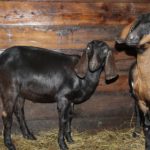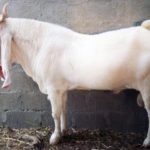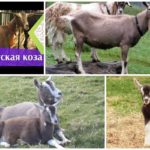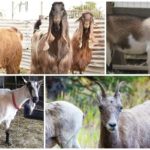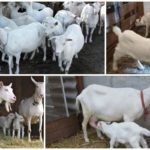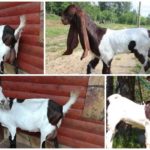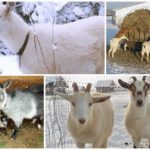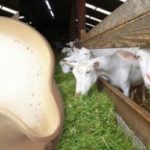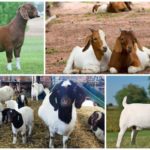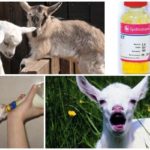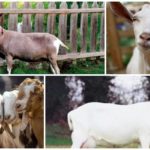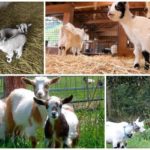The Nubian goat breed has an original appearance, unusual in our area. These animals have a convex nasal septum and floppy ears. When running, Nubians look like rabbits, their ears rise up. The milk of representatives of the Nubian breed is tasty and fatty, odorless. Productivity is 3-6 liters per day. Nubians are very expensive, and their period of economic use is 9-10 years.
History of origin
The Nubian breed is native to northern and eastern Africa.It is in these deserted places that they live goats with long ears and short hair. The breed was slightly improved by the British by crossing African goats with the best representatives of the Alpine breeds. This happened at the end of the 19th century.
In the 20th century, a new Anglo-Nubian breed began to conquer the world. Goats have gained popularity in many European countries and even in the USA. They appeared in Russia only at the end of the 20th century. In just two decades they managed to adapt to new conditions.
It is profitable to breed these animals, because they produce from 3 to 6 liters of milk per day, and eat 2-3 times less than cows.
Characteristics and description of the breed
According to established breed standards, Nubian goats have a convex nasal septum, heavy brow ridges, and wide, thin ears that hang down to the middle of the neck. The height at the withers reaches 70-90 cm, body length - 1-1.2 m. Weight of females - 45-55 kg, males - 65-95 kg. The body is trapezoidal, the tail is short, raised upward, and the neck is long.
Nubian goat eyes, like a deer, and the forehead is massive. There are animals with and without horns. As for color, there are no clear restrictions. Nubian goats can be brown, chocolate, black, white, spotted, mottled, that is, black, white and brown. The coat is usually short and close-lying. The legs are widely spaced, graceful, but strong, thin and long.
This fold-eared breed is distinguished by high milk yield. The Nubian goat produces 3 to 6 liters of milk per day. Its fat content is about 5 percent. The udder of females is large, spherical, highly attached to the body, with two long nipples.
Varieties
There are several types of Nubian goats:
- African.
- Australian.
- Alpo-Nubian.
- Anglo-Nubian.
Animals of different species differ only in the color of their fur. All Nubian goats necessarily have a convex nasal septum and long (to the middle of the neck) wide ears. Crosses with Alpine breeds have an ash-brown coat. Anglo-Nubian goats are often bay and spotted (white and black) in color. African - light, red, black and white or brown and white. Australian representatives of this breed have a brown and white coat color.
Advantages and disadvantages
Advantages of Nubian goats:
- get used to the owner, consider him the leader and obey;
- give 3-6 liters of fat milk per day;
- females give birth annually to 3 kids at a time;
- milk can be used to make yoghurts and cheeses.
Disadvantages of the breed:
- stubborn and willful character;
- loud and harsh voice;
- bleat frequently and demand attention;
- cocky, often butting heads with other animals, cannot live in a herd;
- do not adapt well to the northern climate;
- are expensive.
Keeping goats in homestead farms
The Nubian breed is accustomed to warmth. In the middle zone and in Europe, premises are built to keep these animals. Goats should be kept in a stable or barn throughout the cold period of the year, that is, from November to April.
In summer, animals must be grazed in the meadow so that they eat fresh green grass and are exposed to the sun.
Typically, representatives of the Nubian breed are kept in a barn (shed) with an area of 4 square meters. meters per individual. A straw bedding is laid on the floor. It needs to be cleaned, that is, replaced daily. Dirt and dampness are the main cause of udder diseases in goats. The room where animals are kept must be clean, dry and warm. The recommended temperature is from 15 to 25 degrees Celsius all year round.
Representatives of the Nubian breed are very clean. They do not like to sleep on the floor, on dirty bedding. In the barn they can build a lounger from wooden boards. Nubians love to climb all sorts of heights.
In the room it is necessary to install a manger for hay, feeders for vegetables and grain, and drinking bowls for water. Goats are fed 2-3 times a day. In the summer, they graze in the pasture all day, only at lunchtime they are driven into the barn for a couple of hours. They also milk 2-3 times a day. Before milking, the udder is washed with warm water and the teats are lubricated with fat.
Diet
Representatives of the Nubian breed eat grass in summer and hay in winter. The main thing is to make sure that they do not come across poisonous or soapy plants. In summer, animals can be grazed in the meadow, but only after the dew has dried, and under no circumstances in the rain. Goats should be given clean water between feedings. Preferably 5 liters per adult, 2 times a day. The amount of milk depends on the water.
In winter, Nubians are fed hay. The better its quality, the longer the goats will retain their teeth. It is best to stock up on meadow and forest hay, mowed at the beginning of growth or during the flowering period of plants. Typically, Nubians are fed legumes and cereals, useful plants (nettle, dandelion, chamomile), and always clover and alfalfa.
As a top dressing, animals can be given finely chopped vegetables: carrots, Jerusalem artichoke, pumpkin. Nubians willingly eat beet tops and the root vegetables themselves. Goats recover well from grain (oats, barley, corn, wheat) and boiled potatoes. True, these products can only be given in minimal quantities (no more than 200-500 grams per day).
In winter, to replenish vitamin reserves, animals are fed spruce or pine branches, pharmaceutical vitamin and mineral preparations. Goats willingly eat premixes, cake, mixed feed, chaff, and chaff. Chalk, salt, and bone meal are added to their food. You can simply put salted lick bars in the feeder or attach them to the wall.
Animals love apples and pears. True, these fruits cannot be given whole. They can get stuck in the esophagus and cause gas retention and bloating. If goats are grazing in an unfamiliar pasture, you need to watch what they eat. Nubians are very fond of branches of fruit bushes and trees. This roughage, although healthy, leads to rapid grinding of teeth. It is better to feed them with tree leaves (willow, maple, oak, apple tree); you can even prepare them for the winter.
Features of breeding Nubian goats
Representatives of the Nubian breed reach sexual maturity by 6 months of age. True, it is recommended to cover females only at 1-1.5 years. It is desirable that the male also belongs to the Nubian breed and in no case is a close relative of the goat. On the contrary, you can improve local goats by taking a Nubian goat for insemination.
It is advisable to cover Nubian goats in the fall, then in the spring kids will be born, which can be grazed in the meadow in the summer. Pregnancy in females lasts 5 months. After lambing, young goats begin to be milked. Milking virgin goats is not recommended. If a milking female becomes pregnant, then in the second month of pregnancy they begin to slowly start milking her, that is, they gradually stop milking. It is necessary that nutrients go to the development of offspring, and not into milk. Two months before lambing, milking of a dairy goat is stopped completely.
After lambing, the goat must be milked properly. Once the female has given birth to all the babies, you need to express some colostrum. For the first two weeks, this product should be used as feed for goats. After the cubs have eaten, the female needs to be milked. It is advisable that not a drop of milk remains in the udder. This will be a signal to the body. Milk will begin to arrive in even greater quantities.
At first (immediately after lambing), the goat is milked or kids are allowed near it 5 times a day. Then the female can be transferred to another schedule. They are usually milked 2-3 times a day. After the first lambing, you can get up to 3 liters of milk per day. It is advisable not to cover a goat more than once a year, otherwise too frequent births will lead to exhaustion of the female’s body.
Frequent illnesses and prevention
Representatives of the Nubian breed are heat-loving animals. They have short hair and are poorly adapted to winter. During the cold season, they can catch a cold, get bronchitis and pneumonia. It is advisable not to take these animals outside in bad rainy weather or cold weather.
Nubians can suffer from digestive tract disorders and metabolic diseases. The cause of such diseases is improper feeding and low-quality feed. Excess grains can lead to ketosis. Too much water and legumes cause bloating, or tympany. If animals eat poisonous plants, they may become poisoned. It is always necessary to feed goats with fresh feed, dry soft grass, and finely chopped clean vegetables.
True, it will not be possible to create ideally sterile conditions for these animals. After all, they eat from the ground, often drink water from reservoirs, and come into contact with other domestic animals. Goats, especially those with weakened immune systems, can become infected with various infectious diseases. Many such diseases, according to sanitary rules, are not treated; sick animals are simply sent to slaughter. You can avoid various problems and vaccinate goats at the age of 3 months against the most dangerous diseases. Animals are usually vaccinated against brucellosis, foot and mouth disease, anthrax, and smallpox. As a preventive measure, goats are given antiparasitic drugs 1-2 times a year.
Cost of animals
Nubian goats are rare in our area. These animals have a beautiful and unusual appearance. They produce the same amount of milk as native local goats, that is, 3-6 liters per day. But Nubians are beautiful and very expensive. Each farmer sets his own price. The cost of the animal depends on the purity of the breed.
Typically, Nubian goats sell for $500-$1000. There are breeding individuals of 2-6 thousand. Nubian goats are bought by lovers of rare and exotic animals, since their productivity is no better than that of ordinary goats.
Profitability and prospects
Representatives of the Nubian breed are expensive, the benefit from purchasing them is only in the future sale of purebred kids. The milk and meat of such animals are no different from the products of ordinary goats. If you buy a Nubian for 1 thousand dollars, then in a year she will give birth to 2-3 kids, which can also be sold at the same price. True, it will be necessary to take care of insemination by the breeding goat.
Nubian goats are mainly purchased by owners of private farms. Such animals are not bred on an industrial scale.Their meat and milk are not in great demand in the market.

